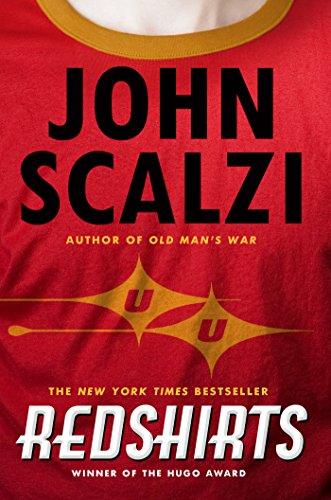
In the opening pages of Redshirts, Ensign Davis is on an away mission for the Intrepid, flagship of the Universal Union. He’s accompanying the ship’s officers: Captain Lucius Abernathy, Science Officer Q’eeng, and Chief Engineer Paul West; and they’ve all been trapped in a cave infested by carnivorous Borgovian Land Worms.
“Davis!” Captain Abernathy called. “Stay where you are! Any movement across that ground will call to the worms! You’ll be eaten instantly!”
Thanks for the useless and obvious update, you jackass, Davis thought, but did not say, because he was an ensign, and Abernathy was the captain. Instead, what he said was, “Aye, Captain.”
Yet despite knowing better, Davis succumbs to some compulsion to do the opposite of what would be sensible in the circumstances. He wants to live, but he’s a redshirt. And everybody knows redshirts die on away missions.
As Q’eeng, the ship’s chief science officer, states at the end of the prologue, “recent missions have seen a sad and remarkable loss of life. Whether they are up to our standards or not, the fact remains: We need more crew.”
Indeed. Enter Ensign Andrew Dahl. Dahl will board the Intrepid, flagship of the Universal Union. He is joined by Maia Duvall, Jimmy Hanson, Finn, and Hester. These “redshirts” will learn of the strange high incidence of death aboard this cursed ship. And along the way they’ll try their best to subvert the tropes of the genre.
From the beginning pages, it’s clear Redshirts is a satire of the original Star Trek. For anyone who remembers the original Star Trek, the TV series ran from 1966 to 1969, this parody/homage will resonant. Trekkies, and even non-Trekkies, might well remember how bit players on Star Trek would bite it on away missions. These anonymous crewman often wore the red shirts. “They always had Kirk and Bones and Spock and then some poor dude in a red shirt who got vaporized before the first commercial.”
There’s no equivalent for Sulu and Uhura, and the Dr. McCoy and Chief Engineer Scottie characters don’t get much play here. The stand-ins for Captain Kirk and Spock, Captain Lucius Abernathy and Science Officer Q’eeng respectively, are not the stars here either. It’s the redshirts who become the main characters here while the “Star Trek” parodies are regulated to background fodder with one exception, Chekov.
Chekhov was a second season addition to the original show. Here, his parallel, Astrogator Anatoly Kerensky, is a bit more important to the story and what unfolds. After looking at Kerensky’s medical report, Dahl says of the officer, “Forget the fact that he should be dead… There’s no way he could be alive and sane after all this. The man should be a poster boy for post-traumatic stress disorder.” This reflection on a main character’s plot armor is a perfect example of how Redshirts explore the tropes of the sci-fi genre, specifically the Star Trek voyage of discovery, and inverts them at the same time.
The original Star Trek introduced characters and a universe that has since spawned numerous spin-offs, movies, derivative works, and fan fictions. It’s worth noting that modern fanfiction essentially began with the advent of Star Trek’s popularity with fans. In the 1960s and 70s, fanzines with stories, often written by women, were distributed at sci-fi conventions. Over time this evolved and expanded to include other fandoms. Now, there’s fanfiction for just about everything… TV shows, movies, book series, comics, games… literally everything. Fanfiction.net is just one site that hosts fans and budding authors’ works, including Star Trek stories and even a Redshirts one!
Published in 2012, Redshirts won the Hugo Award for Best Novel. It’s a fun read that is accessible for those who are new to the sci-fi genre and those who are long-time fans. Shortly after the book was published, there was talk of adapting it for a movie or TV series, but sadly, this has yet to happen. The book would make for an excellent limited series in the vein of the Dirk Gently’s Holistic Detective Agency or Good Omens.
The novel also includes three “short stories” that tease a continuation of this universe (or is it more apt to say, multiverse?). Once the main story ends, there are three coda that further threads involving secondary or minor characters. The first person focuses appropriately on the writer who has discovered his characters are alive. The second person narrative puts readers in the mind of a young man who can’t quite figured out how he survived what should have been a fatal accident. And the third and final coda focuses on a woman who played a beloved wife and wonders if she will find a love as deep. It’s a testament to how good the novel’s world building is that there could be endless ideas for codas.

